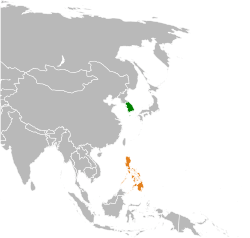Philippines–South Korea relations
 | |
South Korea |
Philippines |
|---|---|
The South Korea–Philippines relations (Hangul: 대한민국-필리핀 공화국 관계; Hanja: 大韓民國-필리핀 共和國 關係; RR: Daehan Minguk-Pillipin Gonghwaguk Gwangye) (Filipino: Ugnayang Pilipinas at Timog Korea) refers to the bilateral relations of the Republic of Korea and the Republic of the Philippines. South Korea has an embassy in Manila while the Philippines has an embassy in Seoul.
Country comparison
History
Bilateral relations between South Korea and the Philippines were established on March 3, 1949 upon the recognition of Republic of Korea as a sovereign state by the Philippines. The Philippines was the fifth state to recognize the Republic of Korea and the first ASEAN country to establish relations with South Korea.[1][2]
Economic relations
South Korea is the sixth biggest trading partner of the Philippines, while the Philippines is the third most attractive Southeast Asian country for South Korean investors in 2011.[3] South Korea also provides the biggest tourist market for the Philippines. Most tourists who went to the Philippines on 2011 were South Koreans, followed by Japanese and Americans.[4]
Military Relations
Military relations between the two countries started during the Korean War when the Philippine Government sent their troops to enforce Allied Campaign against the communist North Korea. South Korea is an active arms supplier for the Armed Forces of the Philippines. They donated some of their F-5A/B fighter jets to the Air Force. They also donated some of their T-41 trainer planes. The SOKOR have sold different small arms to the Philippines.
Recently, SOKOR agreed to sell 12 FA-50 Fighting Eagle multirole fighters to the Philippines. The Philippines received some ships from South Korea.[5]
Others
As of 2011, there are currently more than 90,000 South Koreans in the Philippines. A statistics of South Korea's Ministry of Foreign Affairs and Trade recorded their population. A fall of 16% since 2009 after a period of rapid growth in the population in the preceding decade,[6][7][8] and more than 45,000 Filipinos residing in South Korea.[9]
See also
- Filipinos in Korea
- Koreans in the Philippines
- Philippine Expeditionary Forces to Korea
- Koreans in the Philippines
- Taft-Katsura Agreement
- Root–Takahira Agreement
- Death of Jee Ick-Joo
References
- ↑ "Philippines-South Korea Relations". Philembassy-seoul.com. Retrieved 2013-06-10.
- ↑ http://www.korea.net/NewsFocus/Policies/view?articleId=113844
- ↑ https://web.archive.org/web/20121008033822/http://www.manilatimes.net/index.php/business/top-business-news/31916-ph-seeks-deeper-trade-ties-with-south-korea. Archived from the original on October 8, 2012. Retrieved March 20, 2013. Missing or empty
|title=(help) - ↑ "PH welcomes 1 millionth Korean visitor this year". ABS-CBN News. 2012-12-27. Retrieved 2013-06-10.
- ↑ http://www.businessinsider.com/south-korea-donates-philippine-2014-6
- ↑ 《재외동포 본문(지역별 상세)》, Ministry of Foreign Affairs and Trade, 2011-07-15, p. 104, retrieved 2012-02-25
- ↑ 재외동포현황, South Korea: Ministry of Foreign Affairs and Trade, 2009, retrieved 2009-05-21
- ↑ Meinardus, Ronaldo (2005-12-15), ""Korean Wave" in Philippines", The Korea Times, archived from the original on 2006-01-13, retrieved 2007-02-16
- ↑ "체류외국인 국적별 현황", 《2009년도 출입국통계연보》, South Korea: Ministry of Justice, 2009, p. 262, retrieved 2011-03-21




.jpg)